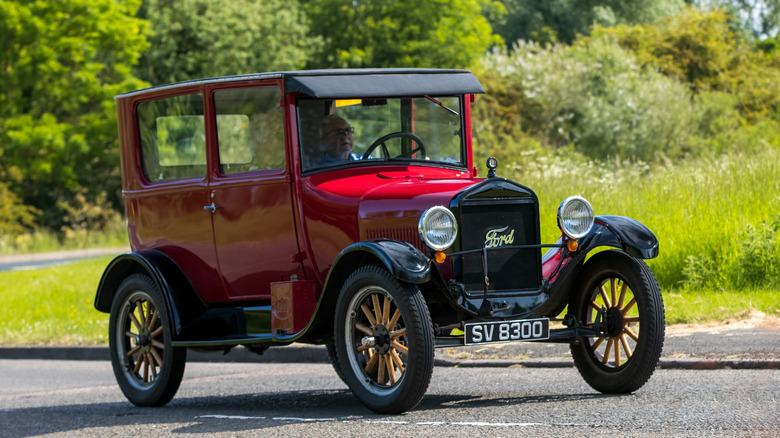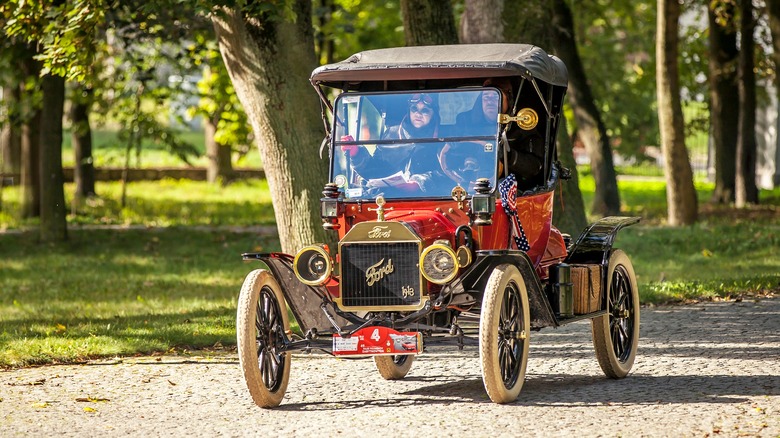Are Ford Model Ts Still Street Legal Today?
Regardless of whether you're a lifelong car addict or someone who only really cares if their car makes it from home to work and back every day, chances are you know about the Ford Model T. More than 15 million were built, and it's believed that around 50,000 are still in working condition today. But it's probably been a while since the last time a Model T drove past you on the street, right? Ford stopped producing the Model T nearly a century ago, so it's no surprise that we don't see many of the iconic antiques on the road any longer.
There are many reasons why this is the case, but legality is not one of them. In fact, Michigan still uses one for official government business: measuring the width of highway shoulders to make sure they're safe for the similarly-sized horse-drawn buggies used by Mennonite residents of the state. But if you want to drive your Model T on public roadways in Michigan or any other state, you'll need to make sure you adhere to the following guidelines.
Use of certain roads might be restricted
Before you jump in the car known by the nickname "Tin Lizzie" and go about your business, it's necessary to familiarize yourself with the rules and regulations of the road where you live. This is because while a Model T is for the most part legal to drive, you will run into some restrictions. For example, depending upon the state where you're planning to drive it, you may find that some roads aren't accessible for your Model T. Rural interstate highways have speed limits of 70 or 85 mph, as well as a minimum required speed of 45 mph.
That's right about the top speed of a Ford Model T, so maintaining that speed on a modern highway is unrealistic. This poses a threat to both Model T drivers and other motorists. While you might be able to drive on the interstate by the letter of the law, it would be uncomfortable and dangerous to travel at about half the speed of traffic. A wiser choice would be to take life at a slower pace and travel on federal, state, or local highways. Moreover, you need to remember that many states require an annual inspection, so ensuring your Model T is in great mechanical shape and compliance with local standards with regards to lights, seat belts, and other equipment is also vital for keeping it road legal. Many classic cars aren't exempt from emissions laws, but Model Ts are old enough to qualify as antiques in some states and don't need regular testing.
The Model T still has appeal today
Even if it's legal to do so, why would anyone want to drive an antique car on today's chaotic and fast-paced roads? Taking a vintage Ford Model T out to share space with oversized pickup trucks and high-powered sports cars is a daunting prospect, and perhaps this is why it's so rare to see a Model T out and about. Regardless, the Model T's historical importance has made it a popular choice for preservationists. Millions of Model Ts were produced between 1908 and 1927, helping put Ford and the American automobile industry on the map. It was the first affordable mass-produced road car, and to this day it remains one of the best-selling Ford models of all time.
Rightfully so, enthusiasts see the Model T as an important piece of American history, and many feel that keeping them locked away in garages and museums is a real shame. Cars like the Model T were made to be used, and used they should be, as this allows enthusiasts and younger generations to enjoy these antiques. For this to be the case, owners must keep their Model Ts well maintained, operating safely, and in adherence with local laws. As long as these guidelines are followed, it's perfectly legal for people to use and enjoy a Ford Model T on the road in 2025 and beyond.


